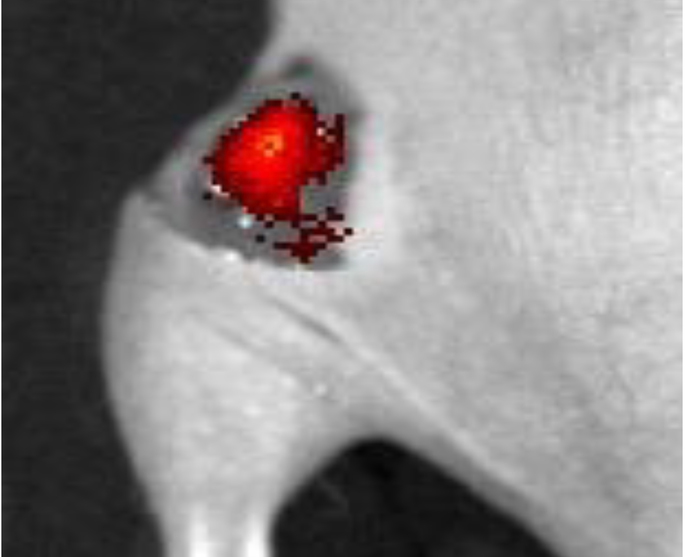Fluorescent spray lights up tumors for easy detection during surgery

A fluorescent probe reveals cancerous tissue (red) 1 minute after being sprayed on a surgical site in a mouse.
Credit: Adapted from ACS Sensors 2021, DOI: 10.1021/acssensors.1c01370
The prognosis for a cancer patient who undergoes surgery is better if the surgeon removes all of the tumor, but it can be hard to tell where a tumor ends and healthy tissue begins. Now, scientists report in ACS Sensors that they have developed a fluorescent spray that specifically lights up cancerous tissue so it can be identified readily and removed during surgery.
Surgeons often use sight and touch to identify cancerous tissue, but this approach can miss small tumors, as well as diseased cells at the margins between a tumor and healthy tissue. Fluorescence-guided surgery is an emerging technology that could enhance this difference. The method relies on fluorescent probes that target cancerous tissue and heighten its visibility. But some of these compounds must be administered many hours or days before surgery —sometimes necessitating a long hospital stay — and they might not reveal tiny tumors. In addition, these compounds can require a large dose if they’re injected, or a washing step to get rid of excess dye if they’re applied to the tumor site. So Ching-Hsuan Tung and colleagues set out to develop a fluorescent probe to rapidly visualize diseased tissue, even on a small scale, when sprayed on a surgical site or injected.
The researchers started with a compound they had previously designed that remains nearly invisible at the neutral pH of healthy tissue, but fluoresces brightly in the near-infrared range in the acidic environment of tumors. That initial compound linked a pH-sensitive amino group with a cyanine fluorophore. It worked when injected, but didn’t produce a signal when applied as a spray, so the team replaced some of its methyl groups with isopropyl groups. That made the new compound more responsive to the acidic tumor environment. When sprayed, it delineated tumor edges in mice within minutes, without the need for washing. And when injected in the abdomen of mice, it illuminated ovarian tumors as small as 1 mm in diameter in an hour. The researchers say the compound could enhance a surgeon’s ability to visualize and remove cancerous tissue.
The authors acknowledge funding from the National Institutes of Health. Tung and other authors are co-inventors of a patent application for the fluorescent spray. Two of the authors are employees of Molecular Targeting Technologies Inc.
The abstract that accompanies this paper can be viewed here.
The American Chemical Society (ACS) is a nonprofit organization chartered by the U.S. Congress. ACS’ mission is to advance the broader chemistry enterprise and its practitioners for the benefit of Earth and all its people. The Society is a global leader in promoting excellence in science education and providing access to chemistry-related information and research through its multiple research solutions, peer-reviewed journals, scientific conferences, eBooks and weekly news periodical Chemical & Engineering News. ACS journals are among the most cited, most trusted and most read within the scientific literature; however, ACS itself does not conduct chemical research. As a leader in scientific information solutions, its CAS division partners with global innovators to accelerate breakthroughs by curating, connecting and analyzing the world’s scientific knowledge. ACS’ main offices are in Washington, D.C., and Columbus, Ohio.
To automatically receive news releases from the American Chemical Society, contact newsroom@acs.org.
Journal: ACS Sensors
DOI: 10.1021/acssensors.1c01370
Article Title: Near-Infrared Fluorogenic Spray for Rapid Tumor Sensing
Media Contact
Katie Cottingham
American Chemical Society
k_cottingham@acs.org
Office: 301-775-8455
All latest news from the category: Life Sciences and Chemistry
Articles and reports from the Life Sciences and chemistry area deal with applied and basic research into modern biology, chemistry and human medicine.
Valuable information can be found on a range of life sciences fields including bacteriology, biochemistry, bionics, bioinformatics, biophysics, biotechnology, genetics, geobotany, human biology, marine biology, microbiology, molecular biology, cellular biology, zoology, bioinorganic chemistry, microchemistry and environmental chemistry.
Newest articles

A universal framework for spatial biology
SpatialData is a freely accessible tool to unify and integrate data from different omics technologies accounting for spatial information, which can provide holistic insights into health and disease. Biological processes…

How complex biological processes arise
A $20 million grant from the U.S. National Science Foundation (NSF) will support the establishment and operation of the National Synthesis Center for Emergence in the Molecular and Cellular Sciences (NCEMS) at…

Airborne single-photon lidar system achieves high-resolution 3D imaging
Compact, low-power system opens doors for photon-efficient drone and satellite-based environmental monitoring and mapping. Researchers have developed a compact and lightweight single-photon airborne lidar system that can acquire high-resolution 3D…





















